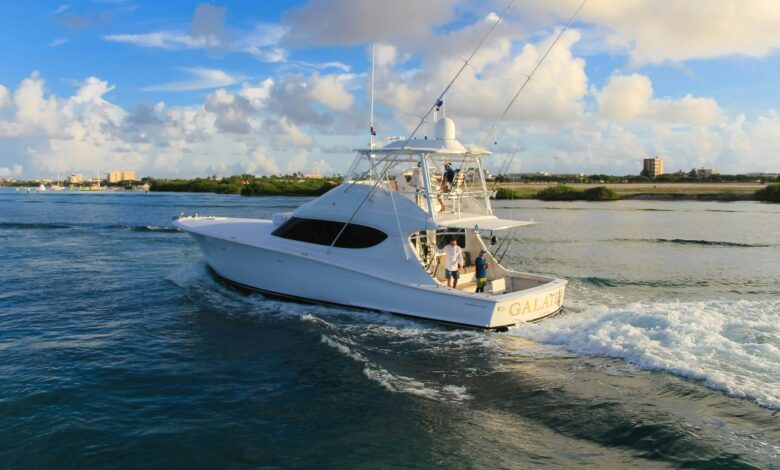
[ad_1]
Springtime brings the promise of warmer weather and the allure of outdoor activities, including boating adventures on lakes, rivers, and coastal waters. However, as nature awakens from winter’s grip, it also presents unique challenges for boaters.
Navigating spring waters requires a keen awareness of potential hazards and a commitment to safety precautions to ensure enjoyable and incident-free outings.
As spring breathes new life into the waterways, it also brings with it a host of unique risks for boaters to contend with. The transition from winter to spring can result in fluctuating water temperatures, unpredictable weather patterns, and increased debris in the waterways.
Cold water immersion poses a significant danger, as the body’s response to sudden immersion in cold water can lead to rapid loss of heat and potential hypothermia. Changing weather conditions, such as sudden storms or strong winds, can catch boaters off guard, increasing the risk of boating accidents and capsizing.
Essential Safety Equipment
- Life Jackets: The cornerstone of boating safety, ensuring that every passenger has access to a properly fitting and U.S. Coast Guard-approved life jacket is crucial. These devices provide buoyancy and can be lifesaving in the event of an accident or emergency.
- Throwable Flotation Devices: Having throwable flotation devices, such as cushions or ring buoys, readily accessible allows for quick assistance to individuals in distress in the water.
- Navigation Lights: Proper lighting is essential for safe boating, especially during low visibility conditions or nighttime navigation. Ensure that navigation lights are in working order and compliant with regulations.
- Communication Devices: Equipping your boat with communication devices, such as a marine VHF radio or a cell phone with a waterproof case, enables you to summon assistance in case of emergencies or to communicate with other vessels.
- First Aid Kit: A well-stocked first aid kit should be onboard to address minor injuries or medical emergencies until professional help can be reached.
- Fire Extinguisher: To mitigate the risk of onboard fires, ensure that your boat is equipped with a Coast Guard-approved fire extinguisher and that all passengers know its location and operation.
Regularly inspecting and maintaining these safety equipment items is paramount to their effectiveness in emergencies. By prioritizing the presence and functionality of these essential safety tools, boaters can significantly enhance their preparedness and ability to respond to potential hazards on the water.
Weather Awareness and Preparedness
Weather conditions can change rapidly on the water, making it imperative for boaters to stay vigilant and informed. Before setting out, it’s essential to check weather forecasts from reliable sources and to monitor updates throughout the day.
Understanding how to interpret weather patterns and signs of approaching storms is crucial for making informed decisions about when to embark on a boating excursion and when to seek shelter.
Boaters should familiarize themselves with the potential hazards associated with different weather conditions, such as high winds, thunderstorms, or fog, and have a plan in place for responding to adverse weather events.
Cold Water Safety
While spring brings warmer temperatures on land, the waterways may still retain the chill of winter, posing significant risks to boaters. Cold water immersion can lead to rapid heat loss from the body, even in relatively mild air temperatures, increasing the risk of hypothermia and cold shock response.
Therefore, it’s essential for boaters to dress appropriately for cold water conditions, wearing layers and clothing that provide insulation and retain warmth even when wet.
In the event of an accidental immersion in cold water, knowing how to react swiftly and effectively is critical. Techniques such as the Heat Escape Lessening Posture (HELP) or Huddle Position can help conserve body heat and delay the onset of hypothermia while awaiting rescue.
Boaters should also be familiar with self-rescue techniques, such as reboarding a capsized vessel or using flotation devices to stay afloat until help arrives.
Navigation and Collision Avoidance
Boaters should familiarize themselves with the International Regulations for Preventing Collisions at Sea (COLREGs) and understand their responsibilities regarding right-of-way, safe speeds, and proper navigation in different water conditions.
In crowded or unfamiliar waters, maintaining situational awareness is paramount. Keeping a lookout for other vessels, navigational markers, and potential hazards such as rocks or submerged obstacles can help prevent accidents.
Boaters should also be mindful of their speed and maintain a safe distance from other watercraft, especially in congested areas. Utilizing navigation aids such as GPS devices, charts, and radar can provide valuable assistance in safely navigating spring waters.
Alcohol and Substance Use Prevention
Boating under the influence of alcohol or drugs significantly impairs judgment, coordination, and reaction time, thus increasing the risk of accidents and fatalities on the water. It’s crucial for boaters to comprehend the legal limits and consequences associated with operating a vessel while intoxicated.
Encouraging responsible alcohol consumption and designating a sober operator before embarking on a boating excursion can significantly mitigate the risk of accidents and ensure the safety of all passengers.
Emergency Preparedness and Response
Creating a float plan and informing others of boating intentions is essential for ensuring that help can be summoned promptly in case of emergencies. Boaters should familiarize themselves with emergency procedures and know how to respond effectively to various scenarios, such as capsizing, engine failure, or medical emergencies.
Carrying emergency supplies, including first aid kits, signaling devices, and spare parts for the boat, can help mitigate the impact of emergencies and improve the likelihood of a successful outcome. Regular training in emergency response techniques, such as CPR and basic first aid, can empower boaters to take swift and effective action when faced with unexpected situations on the water.
Conclusion
As boaters navigate the spring waters, it’s imperative to prioritize safety above all else. By understanding the unique risks associated with spring boating and taking proactive measures to mitigate them, boaters can enjoy their time on the water while minimizing the potential for accidents or emergencies.
From equipping vessels with essential safety gear to staying informed about weather conditions and adhering to navigation rules, every precaution plays a vital role in ensuring a safe boating experience. Additionally, promoting responsible alcohol consumption and maintaining vigilance on the water can help prevent accidents and protect the well-being of all individuals involved.
Ultimately, the goal is to create an environment where boaters can enjoy the beauty of spring waters while minimizing risks and maximizing enjoyment for everyone. With a commitment to safety and preparedness, boaters can navigate the spring waters with confidence, knowing they are well-equipped to handle whatever challenges may arise.
[ad_2]
Source link






